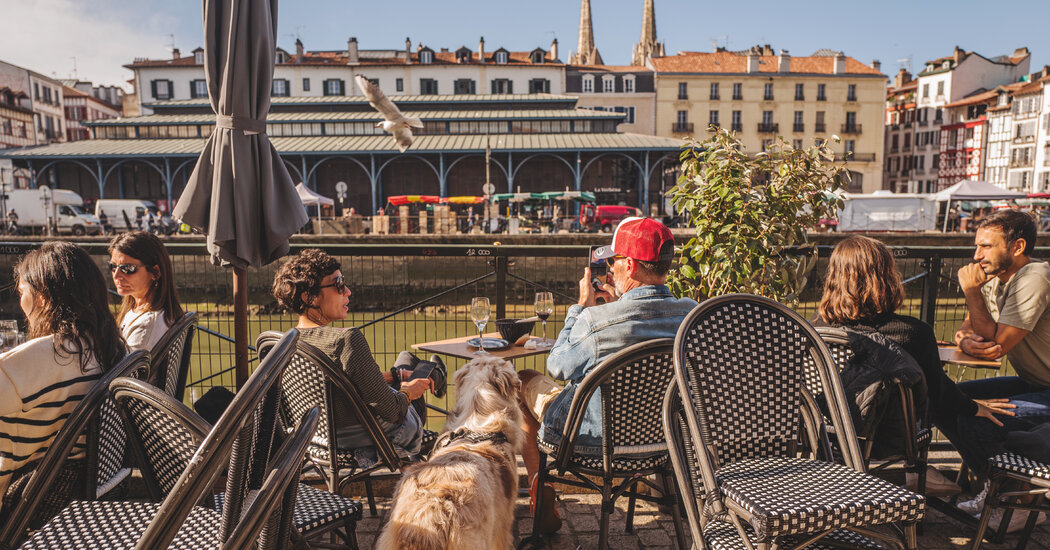This article is part of our special report on global shopping.
BAYONNE, France — The Basque Country, a cultural and linguistic territory without formal borders, first evokes the tourist-choked provinces of northwestern Spain. But on the French side of the Pyrenees mountains is the less known and smaller Basque region with the Atlantic resort towns of Biarritz and St. Jean-de-Luz and of course, with its mellower vibe, Bayonne.
Come to the medieval city of Bayonne for the sights: the Sainte-Marie Cathedral, a UNESCO World Heritage Site on the Camino de Santiago route; the vestiges of Roman walls and medieval fortifications; a Japanese-style Botanic Garden; a museum of Basque history and culture; and the wood-beamed facades of typical Basque buildings with shutters painted red, green or blue.
The pathways along the two rivers that cut through Bayonne’s center make it pleasurably walkable. The narrow Nive river separates the Grand Bayonne and Petit Bayonne neighborhoods, and the wider Adour separates both of them from the Saint-Ésprit area.
Bayonne is four hours on the high-speed train from Paris but a world away from its shopping. More than 80 percent of Bayonne’s boutiques have stayed local. That’s in part because of the architecture: many of its buildings are so narrow that mass-market chain stores have largely shunned the city.
Start in Grand Bayonne on the pedestrian the Rue d’Espagne, a centuries old thoroughfare that runs on the north-south axis that historically connected France to Spain.
Laulhère, the most prestigious beret maker in France, founded near Bayonne in Oloron-Sainte-Marie, began making its famous hats in 1840. Find these creations in a small storefront with an elegant blue façade called La Boutique du Beret.
Laulhère makes berets for the French army, as well as a dozen other countries’ militaries, and a smattering of French luxury fashion houses. Photos of famous beret-wearers — Brigitte Bardot, Madonna, Lauren Bacall, Samuel L. Jackson — are pinned to the walls.
Berets originated in the Bearn region, but after Napoleon III gave them the label “le beret Basque,” the name stuck. They have become a fashion phenomenon even in Paris, where “Emily in Paris”-obsessed tourists are easily identified by the bright berets they sport. The Netflix series “Peaky Blinders” contributed to an increase in sales of the brimmed, 119-euro ($122) Casquette Pau, said Nathalie Bouttier, a saleswoman, and there is even a spangled version named for Che Guevara, who wore a Laulhère beret.
A classic beret here costs 49 euros, but you can also spend 699 euros for a beret sewn with sparkling Swarovski crystals. Laulhère berets are made of merino wool, which, the salespeople will tell you, is resistant to water, moths and allergies. And because of the quality of the materials and production, these berets are said to be a long-term investment. “A young guy came in the other day wearing the beret that belonged to his grandfather!” Ms. Bouttier said.
Along the Rue d’Espagne you will also find handcrafted knives at Les Couteliers Basque; artisanal objects and clothing from places like Indonesia and Iran at Terres d’Orient; and just past the end of the street, Saperlipopette, where beads are laid out in color-coded arrays for clients to touch, and for a designer to make into a custom piece of jewelry.
Espadrilles are a traditional Basque shoe, made on both sides of the border. The capital of French espadrille production (and of the Basque province of Soule) is Mauleon, about an hour’s drive from Bayonne, where espadrille producers celebrate the “Fête de l’espadrille” every August. But if you can’t make it to Mauleon, head to La Maison de l’Espadrille on the Rue Lormand in Grand Bayonne.
Espadrilles — both hand-sewn (16 euros) or machine-finished (14 euros) — come in so many colors that the sales staff has to pull a catalog to show how many are offered. But La Maison de l’Espadrille is much more than an espadrille shop: creative “pantoufles,” or slippers, are also sold here, bargains at factory-to-customer prices. For around 30 euros you can find wool-lined suede slipper-shoes that look as if they should be worn by elves, or buttery backless slip-ons in zebra or leopard patterns.
Then there is Basque fabric, easily identifiable for its stripes, traditionally seven representing the Basque provinces (three French, four Spanish). Produced before World War II in sober colors with garden-grown linen, today it is made in a rainbow of hues of cotton. The only manufacturer who still dyes and weaves its fabrics entirely locally is Lartigue 1910.
Displayed in the Rue Port Neuf boutique are bolts of striped fabric, pure cotton or treated to resist stains; napkins, tablecloths, dish towels; and beach towels, draperies and pillow covers, all made with ecologically produced cotton (GOTS certified) from India. Muriel Baudiffier, the saleswoman, revels in showing customers skeins of colorful cotton thread used in the process.
The Rue Port Neuf is sometimes called “la rue du chocolat,” or the chocolate street, for its many chocolate shops. According to local lore, chocolate was first introduced to France via Bayonne by Sephardic Jews fleeing Spain and Portugal. But Petit Bayonne has Monsieur Txokola, a small, artisanal atelier that is the only to produce chocolate entirely on-site from the cacao beans they procure from all over the world.
Open the door and the smell of chocolate embraces you. You can watch the chocolate-making process through glass walls. Ronan Lagadec, who opened the business five years ago with a partner, peels the outer skin off a roasted cocoa bean so clients can try how crunchy and bitter it is. He offers small glasses of pale cocoa juice made from the pulp of the plant from Quevedo in Ecuador. “It tastes a bit like lychee and pineapple!” he said.
Nearby on the Rue Marengo you can find the Librairie du Levant, one of 15 bookstores in Bayonne and perhaps the quirkiest, where stacks of books at every price point are topped with miscellaneous objects from around the world: Moroccan and Syrian painted vases, cracked Delftware tiles, a stuffed taxidermy raven and fox pair evoking La Fontaine’s fable.
Rent a car or hire a taxi to explore outside of town for a few hours.
We started with a visit to the village of Larressore, where for 200 years the Ainciart-Bergara family has made the “makhila,” or traditional Basque walking stick. The makhila is characterized by a small sword concealed under its handle; for those not defending themselves with it, it’s decorative and functional, if expensive (from 380 euros for a horn pommel and brass decoration, to 770 euros for a silver pommel and decorations.)
Just inside the entrance to the atelier’s front room, you might find Xavier Retegui, who has worked here for more than 30 years, and is the last working artisan to master every step of the makhila-making process. He sits at his tool-filled work space and hammers at the metal pieces that are used on the handle and tip. On the wall, framed photos show celebrities with their makhilas — among them Charles de Gaulle, Pope John Paul II and Sean Penn.
Makhilas are made-to-order with about a two-year wait time; the atelier shows a film of the process, from choosing, scoring, straightening and drying the perfect branch from a medlar tree to hand-weaving the leather trim to crafting and decorating the metal pieces.
“You don’t come here to buy,” said Mr. Retegui. “The first emotion is to come and discover.”
From there I headed 14 miles away to Ascain, where Lartigue 1910 has a factory store. A series of huge looms weaves fabric that workers using powerful sewing machines make into finished products. Most days, Philippe Lartigue, the fourth-generation owner of the business, is there to greet visitors.
The tourist-driven town of Espelette, an easy stop on the way back to Bayonne, is the namesake of the chili pepper that was introduced to France from Mexico as early as the 17th century and has become a staple of Basque cuisine. Strings of Espelette peppers hang to dry from the white houses decorated with dark red shutters.
Espelette pepper is certified AOP, a label issued by the European Union which guarantees its origin and quality. A visitor center in the heart of town screens a film that shows how the pepper must be grown locally from seed, hand-harvested, dried and milled. A 1.4-ounce bottle that costs 6.70 euros here can be almost three times as much in New York.
Back in Bayonne, I needed a sandwich for the long train ride home. So I bought a baguette and brought it to the Pierre Oteiza boutique on rue d’Espagne. Pierre Oteiza is the revered farmer who, starting in the 1980s, led the saving of the Basque pig species “pie noir,” which is used to make jambon de Kintoa (47 euros per pound sliced.)
Chantal Larzabal, the manager, offered samples of seven types of charcuterie and thick slices of a Basque brebis cheese. She sliced some of the precious Kintoa ham, nutty and velvety soft, and hard brebis cheese for sandwiches. But she told me that even if the ham is vacuum-packed, it will not be allowed through American customs.
“Well, I guess this is not the place to send Americans to shop,” I said.
“On the contrary,” she said. “Send them here to taste!”
“But they won’t buy anything to take home!” I protested.
“That’s okay,” said Chantal. “We want to share the richness of all the gastronomy of Basque Country. It will be a pleasure to receive them.”
Charlotte Force contributed reporting.
Sumber: www.nytimes.com












